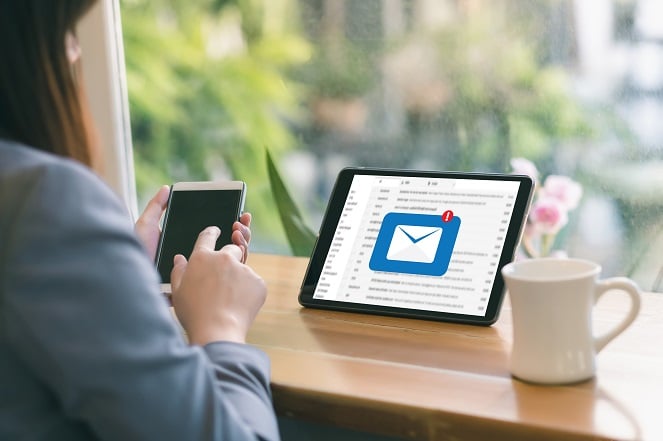Zapis je na voljo tudi v slovenščini
Running an online business can have its disadvantages. One of the biggest challenges is the lack of face-to-face interaction, which makes it difficult to build long-lasting relationships with customers. Email marketing is all about building relationships and one of the most effective ways to personalise communication with your buyer personas.
We’ll be talking here about ecommerce email marketing tips, but if you’re interested in a more general overview of email marketing, also read about Best Practices in Email Marketing.
How can online stores use email marketing?
HubSpot divides ecommerce email campaigns into two categories: newsletters and transactional emails.
When it comes to ecommerce email marketing, newsletters typically include:
- special offers (promotions, discounts, sales etc.),
- products of interest (new items, trending products, etc.),
- accompanying content that complements these products and offers and adds value to them.
Transactional emails are sent after a user has performed a certain action, such as a welcome email when someone subscribes to a mailing list or a confirmation that an order has been received. Transactional emails are the most engaging emails that companies send: They have much higher open and click rates than promotional emails and are therefore a great opportunity for marketers to nurture and convert leads. They can be used to ask users for recommendations or reviews, invite them to make another related or complementary purchase, give them tips on how to use the purchased item, offer special discounts, etc.

Ecommerce email marketing rule #1: Capture the email soon
Email marketing can help you build long-term relationships with customers who have already purchased your products online, but it can also be used earlier in the buyer’s journey to turn visitors into leads and leads into customers.
The first step is to get them on your email list: Instead of waiting for them to make a purchase, give visitors a chance and (a reason!) to sign up before they leave your site. One way to do this is to offer new subscribers a discount code. Some visitors are not yet ready to buy because they are still in the awareness stage – in that case, an ebook or guide that solves one of their challenges is something valuable you can offer in exchange for their email address.
Segment your contact list
Once you have built your contact database, segment your audience into smaller groups and create content that meets the specific need of each segment. Segments can be based on many factors, such as demographic information, existing behaviour, or recent actions they have taken on your website. You can also ask them about their preferences when they first subscribe to your newsletter.
Tools like HubSpot let you track customers from their first site visit to their latest purchase, so you can segment your contacts according to the buyer’s journey and make sure you send the right message at the right time. Each email should educate, engage, delight, and bring value to your readers and move them along the sales process.

Stand out in the inbox
The average person receives a lot of emails every day and you have just about 4 seconds to convince users to open yours. Use engaging subject lines: arouse curiosity and make the reader wonder what’s inside, or create a sense of urgency and scarcity by using phrases like ‘limited edition’, ‘last chance to…’, etc.
Personalising the subject line is always a good strategy, but you should go beyond simply using the contact’s name: consider using their purchase history or geographical location to further tailor the subject line to their specific interests.
Keep the subject line as short as possible (emojis can help you convey a message with fewer characters and catch the reader’s eye). Use preview text to complement the subject line and compensate for the ‘lost’ characters.
Use attractive copy and design
Make sure that all your emails reflect your company’s tone of voice and brand image, as well as the language of your personas. While plain text emails convert more leads than heavily designed emails, images and videos create more impact and help you present your products in a more appealing way. Never rely solely on design though, as some email clients don’t automatically download images.
Optimise content so that it can be read on mobile devices. Use clear and easy-to-read fonts, large call-to-action buttons, clever spacing, and short, concise copy.

Use convincing call-to-actions (CTA’s) – but not too many of them
CTA’s help you guide your customers to a desired course of action and to take them further along the buyer’s journey. To avoid distracting readers from doing what you want them to do, keep it simple – use a single, clear CTA (emails with a single CTA get 371% more clicks). Keep the CTA in the top half of the email so that the reader doesn’t have to scroll all the way down to find it.
Personalise your email campaigns
The more you personalise your emails, the more relevant they are to your subscribers. By sending personalised content instead of generic messaging, you can make your customers feel special.
Based on the data gathered from subscription forms, you can tailor the message to their age, gender, and location. You can send them birthday or other anniversary emails with promotions that encourage them to shop again.
Based on your subscribers’ online behaviour, recent activity, and purchase history, you can provide products and offers that are tailored specifically to their interests.
Once you have segmented your contact list according to the buyer’s journey, you can send them the right messages and information for the stage they are in, and use the content to attract, engage, convert and delight them.
Use automated email sequences
Sequences are a series of targeted, timed emails that are sent within a certain timeframe in a predefined order. They can be triggered by a contact’s action or based on their stage of the buyer’s journey. For example:
- a series of cart abandonment emails are sent after a customer has left products in their shopping cart (include images of the products left in the cart, discount offers, ‘last chance’ prompts),
- a welcome email series is sent when a new contact subscribes (thank contacts for joining, introduce yourself, tell them what they can expect from you, segment new subscribers),
- a series of post-purchase emails are sent after a customer has completed a purchase (confirm the order, introduce other relevant and complementary products or services, include guides on how to use the product, ask for reviews or recommendations),
- a series of replenishment emails is sent to remind customers that they are about to run out of the product and encourage them to reorder,
- a win-back email series is sent after a customer has become inactive (remind them that you still exist, offer incentives, ask for feedback, and lastly, give them a chance to unsubscribe from your list).
Test, measure, analyse

As with everything in the inbound marketing universe, it’s important that you continuously analyse your ecommerce email campaigns and learn what works best for the unique needs of your audience and your business. You can do A/B testing for just about anything: your subject lines, CTAs, content, email sequences,… compare the results and determine how you can adapt your ecommerce email marketing strategy to achieve maximum conversions.
As a certified Vidyard partner, we created an 8 week video sales program to help your sales teams use video in a range of different scenarios.



